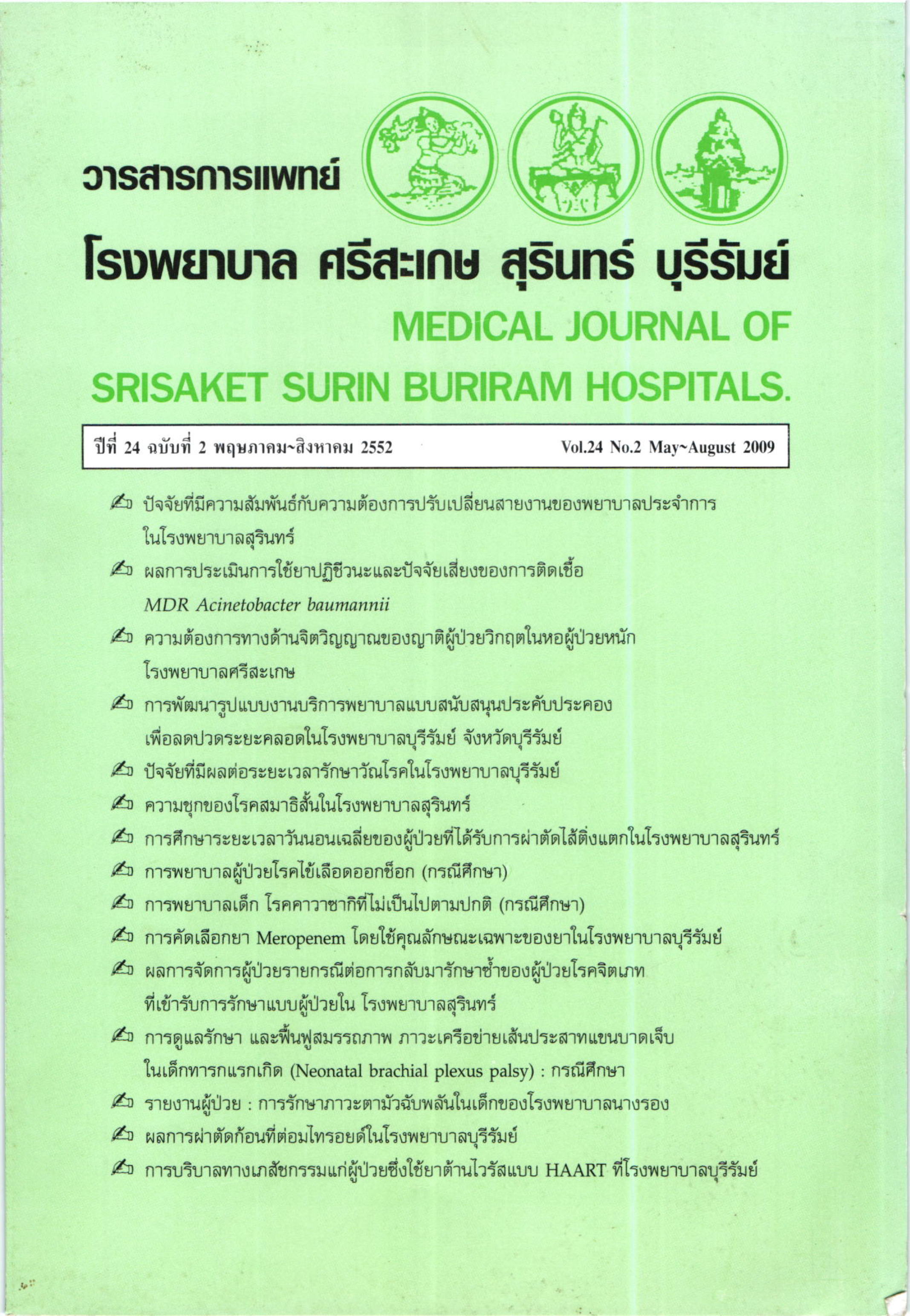ปัจจัยที่มีผลต่อระยะเวลารักษาวัณโรคในโรงพยาบาลบุรีรัมย์
Main Article Content
บทคัดย่อ
บทนำ: วัณโรคนับเป็นโรคติดต่อที่สำคัญ ถือได้ว่าเป็นปัญหาสาธารณสุขทั่วโลก และ มีระยะเวลาของการรักษา 6-12 เดือน ซึ่งยาวนานกว่าโรคติดเชื้ออื่นๆ
วัตถุประสงค์: เพื่อศึกษาปัจจัยที่มีผลต่อระยะเวลาของการรักษาวัณโรค
รูปแบบการวิจัย: การวิจัยเชิงพรรณนาแบบย้อนหลัง
วิธีการวิจัย: ทบทวนเวชระเบียนผู้ป่วยนอกที่ได้รับการวินิจฉัยว่าเป็นวัณโรค ณ คลินิก วัณโรคโรงพยาบาลบุรีรัมย์ ระหว่างวันที่ 1 ตุลาคม พ.ศ. 2549 ถึงวันที่ 30 กันยายน พ.ศ. 2551 ที่ได้รับการรักษาครบหรือหายขาดโดยศึกษาข้อมูลทั่วไป ตำแหน่งของวัณโรค โรคร่วม สูตรยาที่ใช้ ปัจจัยที่มีผลต่อระยะเวลาของ การรักษาวัณโรค ใช้สถิติเชิงพรรณนา ร้อยละ ค่าเฉลี่ย ส่วนเบี่ยงเบน มาตรฐาน, Chi-square ในการวิเคราะห์ข้อมูล
ผลการวิจัย: มีผู้ป่วยในการศึกษาทั้งสิน 331 ราย เป็นเพศชาย ร้อยละ 65.56 มีอายุเฉลี่ย 46.99 ปี ส่วนใหญ่มีอาชีพทำนาร้อยละ 60.73 และอาชีพรับจ้าง ร้อยละ 22.96 มีโรคเบาหวานร่วม 29 ราย ติดเชื้อเอชไอวีร่วม 27 ราย เป็นวัณโรคในปอด ร้อยละ 88.52 วัณโรคนอกปอด ร้อยละ 10.27 และวัณโรคทั้งในปอดและ นอกปอด ร้อยละ 1.21 ในกลุ่มผู้ป่วยวัณโรคปอด ได้รับการรักษาด้วยยา สูตร 1 ร้อยละ 89.6 รักษาวัณโรค 6 เดือน จำนวน 163 ราย คิดเป็นร้อยละ 54.88 และรักษาวัณโรคนานกว่า 6 เดือน จำนวน 134 ราย คิดเป็นร้อยละ 45.12 พบปัจจัยที่มีผลต่อระยะเวลารักษาในกลุ่มผู้ป่วยวัณโรคปอดอย่างมี นัยสำคัญทางสถิติ ได้แก่ อายุตั้งแต่ 60 ปีขึ้นไป มีรอยโรคอยู่ในปอดทั้ง 2 ข้าง หรือมีรอยโรคในปอดตั้งแต่ 2 ตำแหน่งขึ้นไป (advanced lung lesion) และมีรูโพรงในเนื้อปอด แต่ไม่พบความแตกต่างอย่างมีนัยสำคัญ ทางสถิติ ในผู้ป่วยที่มีโรคร่วม เช่น เบาหวาน การติดเชื้อเอชไอวี
สรุป: การกำหนดระยะเวลาของการรักษาวัณโรค นอกจากจะขึ้นอยู่กับสูตรยาที่ใช้ แล้ว ปัจจัยด้านอายุที่มากกว่า 60 ปีขึ้นไป ขอบเขตของรอยโรคที่มาก และ การมีรูโพรงในเนื้อปอด ทำให้แพทย์ตัดสินใจรักษาวัณโรคนานกว่า 6 เดือน
คำสำคัญ: วัณโรคปอด, ระยะเวลารักษา, เบาหวาน, ผู้ติดเชื้อเอชไอวี
Article Details
เอกสารอ้างอิง
2. Resolution WHA44.8. Tuberculosis control programme. In: Handbook of resolutions and decisions of the World Health Assembly and the Executive Board. Volume III, 3rd ed. (1985-1992). Geneva, World Health Organization, 1993 (WHA44/1991/REC/1):116.
3. Raviglione MC, O'Brien RJ. Tuberculosis. In: Fauci Anthony S, Kasper Dennis L, Longo Dan L, Braunwald Eugene, Hauser Stephen L, Larry Jameson J, [et al.], editors. Harrison's Principles of Internal Medicine 17th ed. Singapore : McGraw Hill, 2008:1006-20.
4. World Health Organization. Global tuberculosis control. Annex 1-profiles of high-burden countries. World Health Organization, 2008. Availble from: URL: https://www.who.int/tb/publications/ global_report/2008/annex_l_download/ en/index.html
5. วรวุฒิ เจริญศิริ. วัณโรค. Availble from: URL: https://www.bangkokhealth.com/sitesearch_detail.asp?Number=9481.
6. สถานการณวัณโรคในประเทศไทย. Availble from: URL: https://origin.www.voanews.com/thai/archive/2008-03/2008-03-25-voa3.cfm?CFID=211746197&CFTOKEN=62491472&jsessionid=00307017289a9529235f474f7d5bc3247714.
7. ยุทธิชัย เกษตรเจริญ, เพชรวรรณ พึ่งรัศมี. Management of Tuberculosis modified WHO modules of managing tuberculosis at district level. กรุงเทพฯ : โรงพิมพ์ชุมนุมสหกรณ์การเกษตรแห่งประเทศไทย, 2540.
8. Centers for Disease Control and Prevention. Prevention and Treatment of Tuberculosis Among Patients Infected with Human Immunodeficiency Virus: Principles of Therapy and Revised Recommendations. MMWR 1998; 47(20):1-51.
9. Wang JY, Lee LN, Hsueh PR. Factors changing the manifestation of pulmonary tuberculosis. Int J Tuberc Lung Dis 2005; 9:777-83.
10. Jeon CY, Murray MB. Diabetes Mellitus Increases the Risk of Active Tuberculosis: A Systematic Review of 13 Observational Studies. PLoS Medicine 2008;5(7):1091-101.
11. Nissapatorn V, Kuppusamy I, Josephine FP, Jamaiah I, Rohela M, Khairul A. TUBERCULOSIS: A RESURGENT DISEASE IN IMMUNOSUPPRESSED PATIENTS. Southeast Asian J Trop Med Public Health 2006;37(3):153-60.
12. Pulido F, Pena J-M, Rubio R, Moreno S, Gonzalez J, Guijarro C, et al. Relapse of tuberculosis after treatment in human immunodeficiency virus-infected patients. Arch Intern Med 1997;157:227-32.
13. Kassim S, Sassan-Morokro M, Ackah A, Abouya LY, Digbeu H, Yesso G, et al. Two-year follow up of persons with HIV-l-and HIV-2-associated pulmonary tuberculosis treated with short-course chemotherapy in West Africa. AIDS 1995;9:1185-91.
14. Perriens JH, St. Louis ME, Mukadi YB, Brown C, Prignot J, Pouthier F, et al. Pulmonary tuberculosis in HIV-infected patients in Zaire: a controlled trial of treatment for either 6 or 12 months. N Engl J Med 1995;332:779-84.
15. American Thoracic Society Documents. American Thoracic Society/Centers for Disease Control and Prevention/Infectious Diseases Society of America: Treatment of Tuberculosis. Am J Respir Crit Care Med 2003; 167:603-62.
16. Storla DG, Yimer S, Bjune GA. A systematic review of delay in the diagnosis and treatment of tuberculosis. BMC Public Health 2008, 8:15.doi:10.1186/ 1471-2458-8-15 Availble from: URL: https://www.biomedcentral.com/1471-2458/8/15.
17. Lee JH, Han DH, Song JW, Chung HS. Diagnostic and Therapeutic Problems of Pulmonary Tuberculosis in Elderly Patients. J Korean Med Sci 2005;20:784-9.
18. Sterling TR, Alwood K, Gachuhi R, Coggin W, Blazes D, Bishai WR, Chaisson RE. Relapse rates after short-course (6-month) treatment of tuberculosis in HIV-infected and uninfected persons. AIDS 1999;13:18991904.


